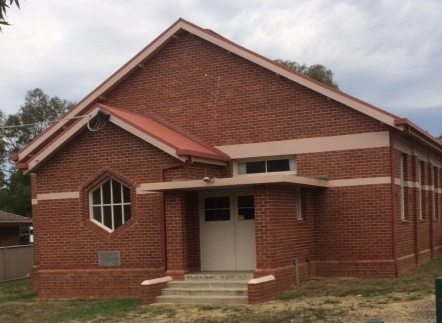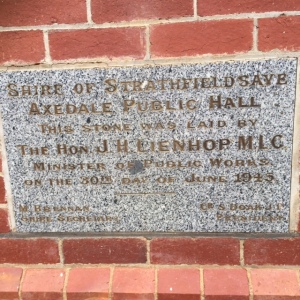This is a great article of memories of the Axedale Public Hall and social life in a small country township.
from: Axedale Antics, Issue 145, August 2008
As we drive through Axedale, the centrepiece of our small township is our local Hall. Set in a surround of lovely old pepper trees, so typical of a northern Victoria town, it features picnic tables, a barbecue, a playground/skate ramp and entices many tourists passing through the region to stop a short while, take a break, enjoy a cuppa and make use of the facilities. We often wonder what impression the travellers gain of our town. Do we ever ask ourselves how fortunate we are to have such a well kept meeting place? Who built it originally? Who maintains it?
Our inaugural Australia Day Breakfast on January 26, 2008 (don’t forget to put it in your diary for next year) proved what a boon the local hall is to Axedale; the ideal venue for a laid-back community celebration of what it is to be an Aussie. Down through the years our hall has proved to be the hub of social interaction within the community, hosting dances, balls, concerts, school break-ups, family celebrations, farewells, meetings and various fund-raising efforts.
Before the present hall was built, halls connected to the two main hotels were used for meetings and dances. ‘Accent on Axedale’, published in 1970, tells us that “in 1927, Mr.W. Millington called a meeting to decide on ways of financing the erection of a Mechanic’s Institute or hall”. As a result, a committee was formed with P.O’Dwyer as the Chairman and W. Millington, the Secretary.
Various fund raising efforts were held over the years; mainly the annual sports and picnic days at the reserve. Finally with the help of a Government grant, the hall was built. It was opened by the Hon. J.H. Lienhop M.L.C. on December 12,1945. A debutante ball was held on December 28 1945, with 13 local girl forming the set. A Younger Set was formed with the proceeds of this first debutante ball. They bought some of the seats and the piano. They disbanded in 1951, and the remaining money was handed to the hall committee. It was to be very many more years, however, before the hall was finally paid for.

It must be remembered, that back in those days the social life of a community revolved around formal gatherings or entertainment. There was no TV, DVD or internet, mobile phones only limited transport and the cinema was a rare treat. Does anyone else remember ‘tea meetings’ and ‘lantern lectures’. These were generally held in connection with one of the churches, and often involved a visiting missionary, newly arrived from darkest Africa or some remote island community. Endless slides of native children singing hymns were shown to an audience, usually huddled under blankets or travel rugs to keep warm, and very often the projector would ‘blow up’ halfway through the performance which concluded with a collection for the mission.
These are my childhood memories, but, although they were set in a different part of Victoria, undoubtedly, Axedale residents experienced similar social functions.
‘Kitchen Teas’ were popular in my township, and nearly every bride-to-be in a country town would be asked to nominate the colour scheme of her future kitchen and people from far and wide would gather at a dance in the local hall, bearing a small gift in the appropriate colour way; ‘cream and green’, ‘cherry and cream’, ‘blue and white’, etc. A large trestle table on stage would be covered with sieves, cake tins, canisters, rolling pins, basins and all the myriad of kitchen gadgets, pot holders and tea towels needed to equip the new home. Sometimes there would e a wallet of cash to help with wedding expenses, and even the gift of clothing coupons during war time rationing. Those attending would not necessarily be wedding guests; just well wishers, casual friends and neighbours.
Another custom which occurred a few weeks after a newly-wed couple arrived home from their honeymoon, was the ‘tin-kettling’. Many a couple, wife with hair in curlers, husband unshaven and pyjama clad, would be disturbed by an almighty din outside their matrimonial home. On investigation, it would prove to be a group of friends and neighbours bearing plates of supper and creating a ruckus, to welcome home the newly married couple.
In the district where I was raised, there was such a dance in the local hall, every Saturday night. The dance band, and often a family group, would usually consist of a piano, saxophone and drums (no guitars), and the program was normally 50/50, meaning half old-time and half fox-trot. This was before the days of rock and roll, but I clearly recall the jive and jitterbug! Many of the dancers wore uniform and often the function was a welcome home for a veteran, or to farewell a young person off to to war. The older men and matrons of the town would prepare the hall, wax the floor, decorate, organise the music and the supper, then retire to the supper room to play Euchre until refreshments were required. Children danced together and learned ballroom dancing while their Mums played cards.
Once girls turned 16, (there were no ‘teenagers’ in those days), it was usual for them to ‘come out’ at a debutante ball. It was the custom for a young lady to put her hair up and wear her first long white dress. She could then attend the balls, which were the special occasion fundraisers in country towns. ‘Belle of the Ball’, ‘Star of the Evening’, ‘Young Farmer of the Year’, all of these competitions carried sashes for the winners and every girl had a number of ball gowns in her wardrobe. Very often bridal gowns were designed in such a way that by the addition of a bolero and the removal of the train, a useful ball gown was the result. Overskirts were added, gowns were dyed a different colour etc. Our forebears were a thrifty generation, but they knew how to enjoy a rich social life.
A good friend once told the story of a Saturday night dance in a Mallee township where a stranger pulled up his truck to the doorway of the local hall. Wearing shorts, army boots, no socks, a singlet and a hat, he asked each girl in turn to dance. When no-one would accept his invitation, he stomped out, returning with a hatful of wheat, which he threw across the dace floor. “If I don’t dance, nobody dances”, he said before roaring off in his truck. My friend was amazed when the locals calmly grabbed brooms and swept the floor, before resuming dancing as if nothing had happened.
When I came to Axedale 44 years ago, the effects of TV, the cinema (or the ‘pictures’, as we called it, drive-ins and the availability of transport had changed the social lives of country people and our local hall was not receiving the amount of use it required to pay off the remaining debt.
In our next issue we will explain what happened to save the day, and to ensure that our Hall remained the magnificent asset it is today.
….more to come in next post
**written by Axedale resident Lorraine Gunn






